On paper, the DFB Pokal quarter-final was a one-sided affair, no arguments there. Hans-Dieter Flick’s Bayern Munich claimed 78% possession and reduced their opponents to only one attempt on target for the whole game. However, stats do not always tell the real story, as we know, fine margins separate winners at the highest level and today’s game was no different.
Only one goal decided this tie, and it came in the late stages of the first half. As Schalke 04 were defending a Bayern corner, a defensive header was met by Bayern’s young centre-back Joshua Kimmich. The German struck low from a volley on the edge of the box, and the ball hit the side netting, not before passing through the legs of two Schalke players attempting to block the shot. Although only having only 22% possession and averaging one attack every five minutes, David Wagner’s game plan was within inches of being considered a success. As his Schalke side hit the crossbar early in the first half and having what seemed a perfectly good goal reversed as replays showed the striker was offside by, you guessed it, inches, it was Bayern’s moment of good fortune sent them through to the semi-finals.
The tactical analysis below tells the story of the game from a tactical standpoint. Considering the most prominent aspects of both teams style of play and the tactics deployed by both managers, we show how both teams set up to execute their game plans and get success. With the support of key data and statistics, we are better able to understand where the game may have been won or lost.
Lineup
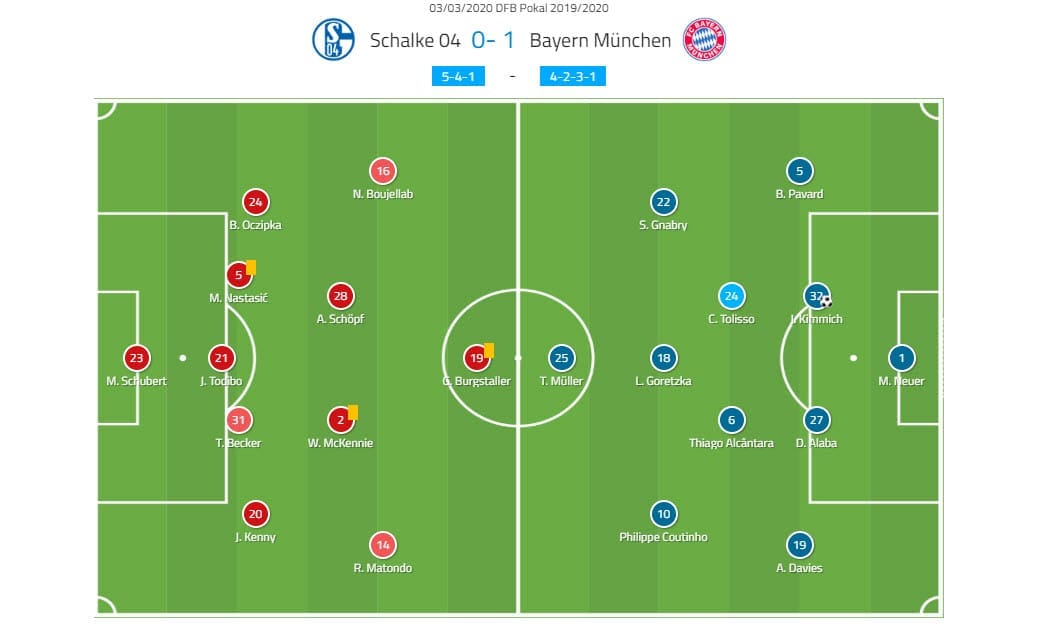
FC Schalke 04: 5-4-1
Wagner makes six changes to the side that fell to a 3-0 loss away to Koln last weekend in the league. Alexander Nübel vacates his position in goal in favour of 21-year-old Markus Schubert. Ozan Kabak is also withdrawn from the backline to be replaced by Jean-Clair Todibo, while Amine Harit is withdrawn from his midfield post to allow Timo Becker to join the backline as a fifth defender. Towards the front Benito Raman was dropped in place or Rabbi Matondo and centre-forward Michael Gregoritsch makes way for 30-year-old Austrian Guido Burgstaller.
FC Bayern München: 4-2-3-1
Flick makes only two changes to the side that ran six goals past Hoffenheim the previous week. Jérôme Boateng makes way for the 25-year-old French international Corentin Tolisso in centre-midfield as Joshua Kimmich drops back into centre-back beside David Alaba. Frontman Joshua Zirkzee departs and offers his spot to veteran Thomas Müller who moves up from his recent midfield role allowing the German international Leon Goretzka to play as the number ‘10’ just behind Müller in front.
Bayern’s shape and movement in attack
Bayern was offered more freedom to develop prominent attacks than usual as Schalke resigned to a deep block with low pressure. In an attempt to engineer good goal-scoring opportunities from wide areas, the Bavarian’s kept a high tempo in their passing as they moved the ball from flank to flank to finds an opening. Helped by the stand-off-ish Schalke frontmen Bayern’s centre-backs and full-backs played at very close distances to the midfield. Both left and right-midfielders Phillipe Coutinho and Serge Gnabry served to stretch Schalke horizontally while both full-backs Alfonso Davies and Benjamin Pavard offered penetrating runs and crossing opportunities. Müller and Goretzka were both target men as well as playmakers between the lines, helping to develop central attacks and create spaces for midfielders to attack crosses. The visitors had a tough task in breaking down the back-five of Schalke, out of 20 attempts on goal only three shots found the target.

In the image above, we see the balanced shape in Bayern’s attacking organisation. Notice the wide midfielders occupy the widest positions on the field while the full-backs offer a shorter distance of support to the midfielders. Neither full-backs played on the same vertical line to the wingers, and this remained throughout the game. The centre-midfielders seldom played on the same horizontal line to each other as they made well-timed runs to receive the ball in pockets of space behind the Schalke midfield.
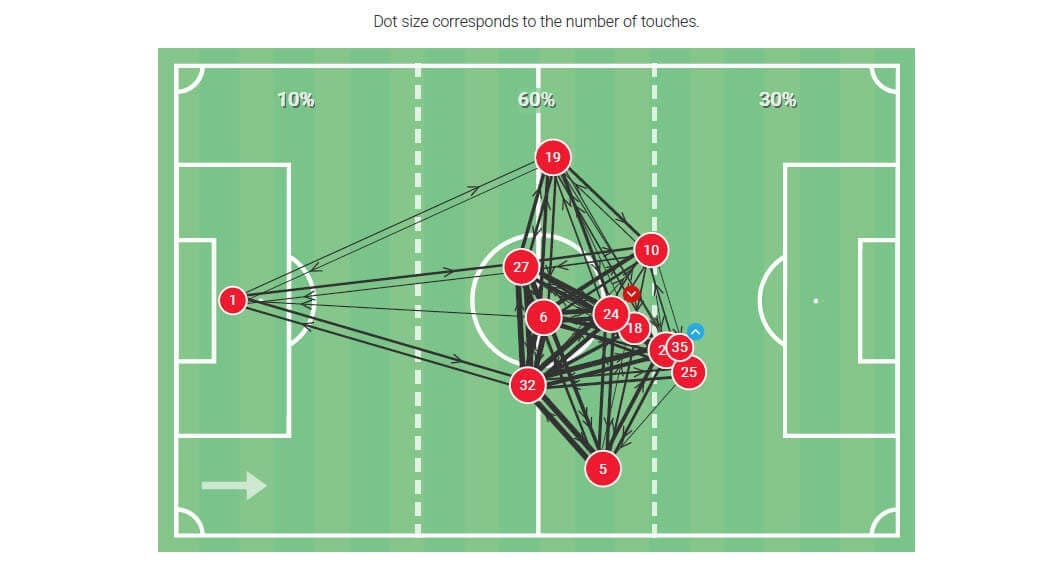
Above, we see Bayern’s passing network in the game. Accounting for combinations of three or more passes the dot sizes also represents touches per player while the positioning of the players represents their average position in possession. We can see evidence above of how both central-midfielders were the link between the defenders and forwards. Bayern had an average passing distance of 20 metres and a superior pass accuracy of 90%. When we account for Schalke’s PPDA (allowed passes per defensive action average) of 32.2 passes, we can see by Bayern’s setup how they managed to get such success in retaining possession. The Bavarian’s achieved a completed pass rate four times that of their opponent, 821 passes.

As Schalke played a high line to engage the offside trap while the Bayern centre-backs were in possession, this meant the distance between Schalke’s defence and midfield was short and very compact. Subsequently, this meant centre-forward Müller could not receive many passes to feet as he aimed to play between the lines and link passes to the wide players. As the first half wore on, Müller changed his function to create space and receive a pass unmarked. The German would occupy an offside position between the centre-backs until he was ready to receive a pass from deep. Once a forward pass was available, Müller would sprint back onside unmarked to receive a pass and continue the attack into wide areas with a forward pass to the wide midfielders. This worked well when Bayern was struggling to play through the block.
Schalke’s masterful defending
Schalke were masterful in their defending, distances between players, choosing when to press and when to drop, positioning themselves to block crosses and screen forward passes as well as long-range defensive headers and clearances Die Königsblauen done well to reduce Bayern to an xG of 1.01.
The deep block
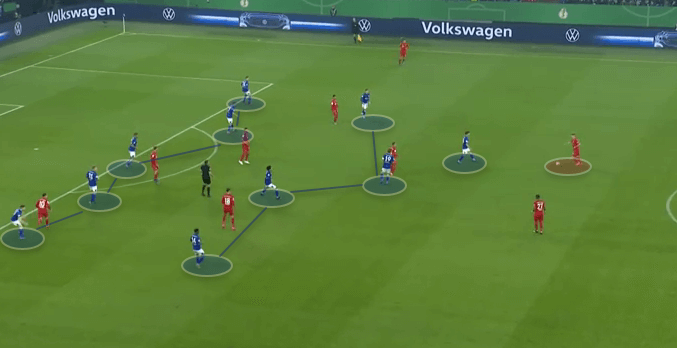
Above, we see Schalke defend in a 5-4-1, forming a deep block as Bayern offer all ten outfielders to the offensive phase. Because the backline is close to the goalkeeper, this means there is no opportunity to play dangerous passes over the top. Also as the four Schalke midfielders are centrally compact and close to the defence, meaning they deny central passes forward for Bayern, therefore not pressing the Bayern centre-backs in this situation is smart. As the ball carrier is not posing a threat, pressing him may serve to cause an opening for the Bayern attack.
The offside trap
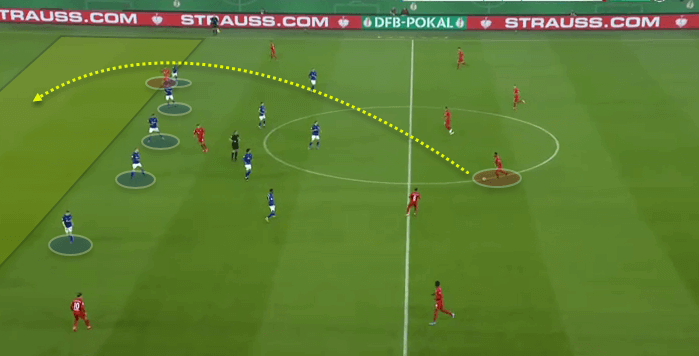
When the Bavarian’s were in possession in the middle third, Schalke opted to hold a high line until play went wide to create an offside trap. The backline was disciplined, and the trap worked well as Bayern did not catch beat the trap once and were subsequently caught offside five times. Had Schalke opted to drop deep and prepare for long direct passes; then they would have helped Bayern play and receive passes in between the lines which would have been more dangerous. Whereas how they set up to play an offside trap in central areas served them much better in nullifying the Bayern attack.
Blocking penetration in wide areas

Schalke done well to neutralise the Bayern attacks in wide areas. In central areas, we saw Schalke form a block and allow the visitors to play into tight spaces before pressing. Once the attack reached the wide areas, the hosts would engage the press to block any ground pass penetration or crosses to the box. Having a back five meant Schalke would not become unbalanced as they pressed and the attacker while supporting midfielders would shift across to deny Bayern numerical superiority or penetration. These were also the areas of the field Schalke targeted as their moment to win possession and counter-attack a disorganised Bayern defence.
Müller’s movement unlocks the cross
Due to the vertical compactness of Schalke’s lines as well as having a back five to meet wide attacks comfortably Bayern needed to alter their approach in wide areas to breach the defensive line and create spaces to deliver crosses. Considering the wide players were matched-up by the Schalke defence, it was Müller’s movement in support to link passes going forward that helped the Bavarian’s find their breakthrough in the form of crosses.

Above, we see Müller makes a well-timed run to receive an attacking pass from the centre-back unmarked. Two aspects are important to note about this movement, firstly, Müller is coming from behind the defender, so he is already moving towards the ball before the centre-backs have time to follow and pressure him. Secondly, there is a simultaneous vertical rotation which pins the defenders back. As we can see in the image above, the ‘CAM’ and the ‘RB’ make penetrating runs if a centre-back follows Müller, then there will be an opportunity for a killer ball to match the attacking runs from deep to create good chances to score. The Bayern forward played a crucial role in graduating the attacks further into wide areas.

Notice in the image above, after a spell of good movement from Bayern, the centre-midfielder makes a run on the blindside of the full-back where he collects a pass from Müller. It was Müller’s initial movement and attacking pass that unlocked the opportunity to create a high-value crossing opportunity. After playing the pass to the crosser, Müller gets forward to meet a potential cross.
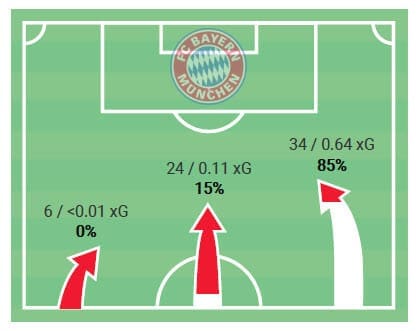
In the data set above, we see Bayern’s attack by flanks which reached the final 35 metres of the field. Going from left to right, we see the volume of attacks to be 6, 24 and 34 with corresponding xG ratings. Considering we know how Schalke set up to defend by blocking and not pressing centrally in their third, we can quickly establish how the number of attacks to reach the final third centrally is so high.
Schalke’s plan for success in transition
The moment Schalke won back possession, no opportunity to counter-attack a disorganised backline of Bayern would be missed. Almost every transition to attack went forward from Schalke, and the rewards of finding the target were narrowly missed on multiple occasions. Often times teams are accused of lofty aimless clearances or not willing to play football when they force the counter-attacks. Schalke however, for the minimal spells of possession were efficient as they were targeting these moments to get success.
At the moment Schalke transitioned to attack, the ball carrier would not turn back to safety but hold a forward position to play an attacking pass to supporting runs from deep. Frequently it was the channels vacated by Bayern’s full-backs Davies and Pavard that were exploited in the counter-attack.
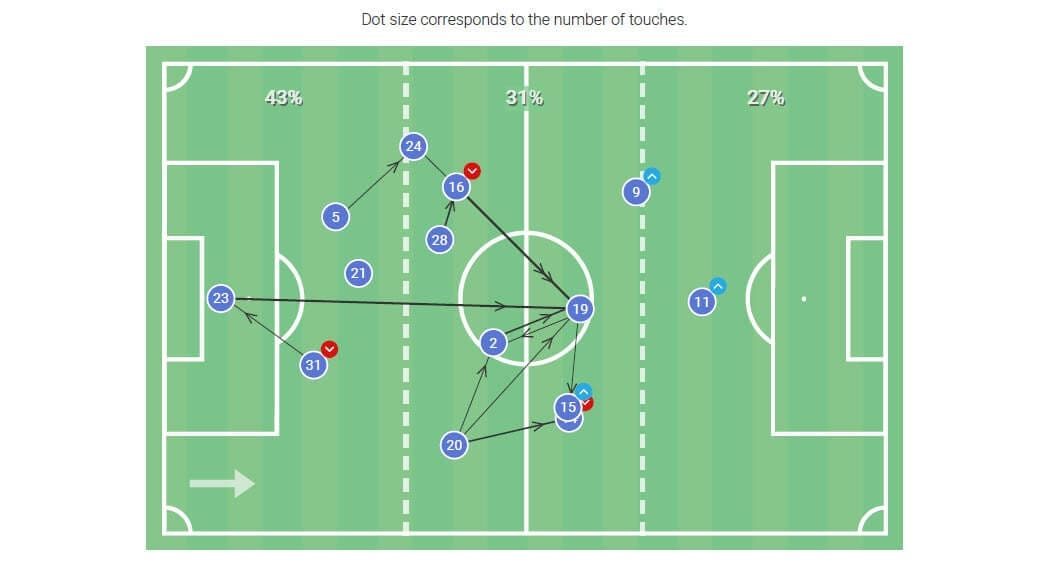
Above, we see Schalke’s passing network per 90 minutes. For the 22% possession, Schalke claimed we could see they had no interest in building attacks slowly from deep or re-circulating possession to the opposite flank. Which would have in turn raised their possession % however, their plan to get success was immediate and forward when they transitioned to attack.
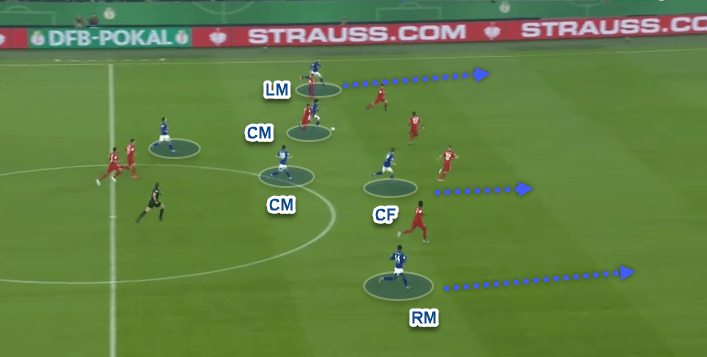
Above, we capture a moment which summed up Schalke’s attacking intentions. Moments before the ball carrier picked up possession, neither the ‘RM’ or the ‘LM’ was nearly as high as they are when the image is taken. Once possession is won, the Schalke wingers, Rabbi Matondo and Nassim Boujellab are at full speed going forward to offer passing options forward and develop dangerous attacks.
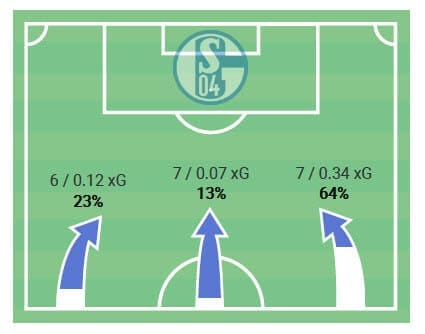
The data above represents Schalke’s attack’s by flanks with corresponding xG ratings. The better opportunities to find the target came from attacks down Bayern’s left side. Schalke counter-attacked five times across the 90 minutes with the perceived better chances coming by way of this same side.
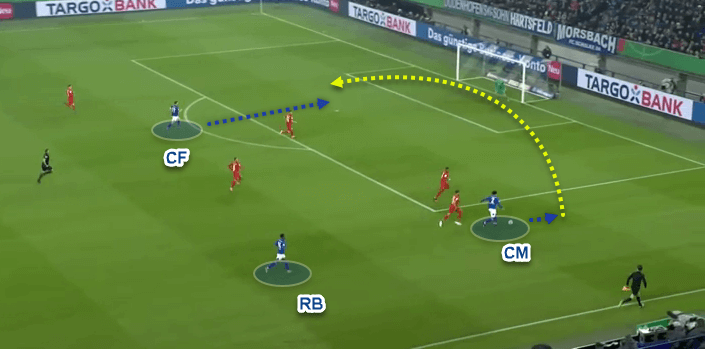
Moments after Schalke win possession no more than two passes are played before the ball carrier ‘CM’ is about to deliver an excellent cross to meet the run of the ‘CF’. The ‘CF’ has taken an excellent line as he is on the blindside of the deepest Bayern defender and is also targeting the back post, so he has both a view of the ball and the goal when a cross is delivered. A great opportunity to score for the hosts that went amiss as the resulting shot hit the crossbar.
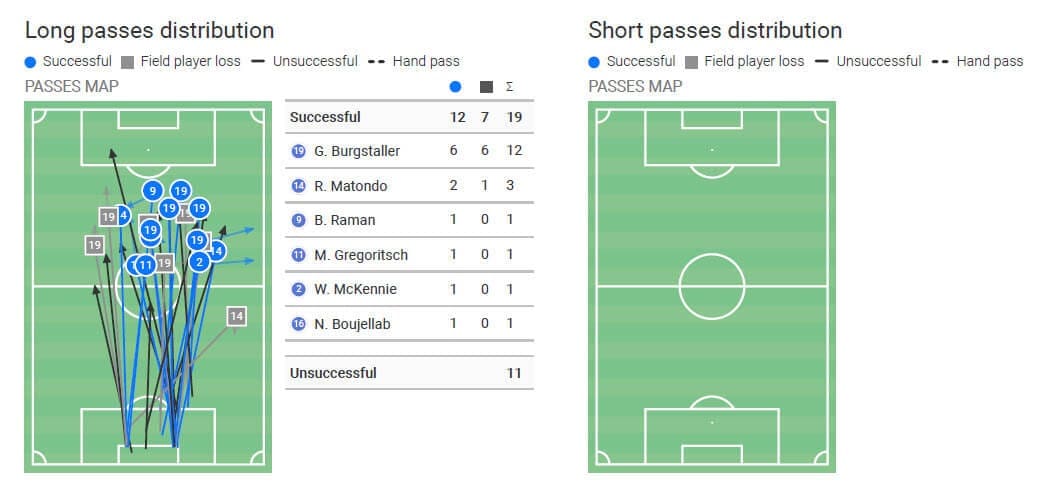
For all of Schalke’s 19 goal kicks, we see they opted for long-range ariel passes 100% of the time. None of Schubert’s goal kicks resulted in a fruitful attack, which subsequently meant the hosts had to reorganise quickly in their defensive shape only moments after they were hoping to get some secondary success.
The rewards for a quick transition forward or a counter-attack is not always the targeted goal itself but the secondary success that is created from these moments. For example, when Schalke won back possession and countered, they drew fouls from recovering Bayern players whereby free-kicks and corner kicks were won. Although nothing came of these set-pieces, these were high-value opportunities only narrowly missed and as a result of these fouls by recovering defenders lead to bookings which as we all know can change a game.
Conclusion
Perhaps the summary can seem much like an oversimplification, such as Schalke intended to nullify the threat out of possession, soak up the pressure and reply with counter-attacks to get success. However, this strategy took nothing less than masterful preparation and execution in and out of possession. For all the possession, territory and the high volume of crosses delivered to the strikers, the mighty Bavarian’s could not conjure anymore than an xG rating of 1.01. Which only highlights Schalke’s plan and ability to control the game out of possession. Although like we said, in the beginning, it’s fine lines that separate games and it was the slightest error closing down a rebounded shot that has Schalke missing out on DFB Pokal glory.
Credit to Bayern, the Bavarian’s go marching into the semi-finals as they take one step closer to retaining their DFB Pokal title. This goes along with their Bundesliga resurgence in the second half of the season and excellent Champions League form. For the hosts, they live with ‘what ifs’ and learning opportunities as they must wait until next season to pursue a DFB Pokal title since 2011.
To track the progress of FC Schalke and FC Bayern München and get lastest match analysis of both these teams including all further DFB Pokal action, be sure to check back in with us here at totalfootballanalysis.com.





Comments